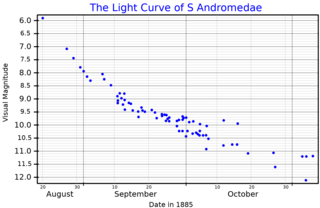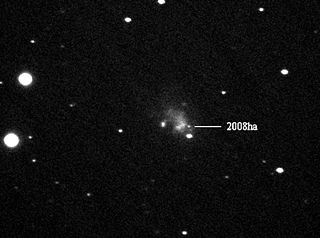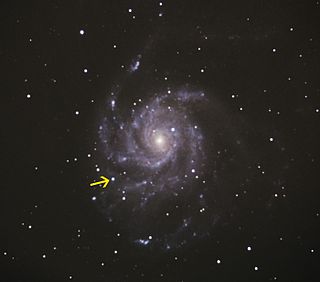
A supernova is a powerful and luminous explosion of a star. A supernova occurs during the last evolutionary stages of a massive star, or when a white dwarf is triggered into runaway nuclear fusion. The original object, called the progenitor, either collapses to a neutron star or black hole, or is completely destroyed to form a diffuse nebula. The peak optical luminosity of a supernova can be comparable to that of an entire galaxy before fading over several weeks or months.

SN 1604, also known as Kepler's Supernova, Kepler's Nova or Kepler's Star, was a Type Ia supernova that occurred in the Milky Way, in the constellation Ophiuchus. Appearing in 1604, it is the most recent supernova in the Milky Way galaxy to have been unquestionably observed by the naked eye, occurring no farther than 6 kiloparsecs from Earth. Before the adoption of the current naming system for supernovae, it was named for Johannes Kepler, the German astronomer who described it in De Stella Nova.

The cosmic distance ladder is the succession of methods by which astronomers determine the distances to celestial objects. A direct distance measurement of an astronomical object is possible only for those objects that are "close enough" to Earth. The techniques for determining distances to more distant objects are all based on various measured correlations between methods that work at close distances and methods that work at larger distances. Several methods rely on a standard candle, which is an astronomical object that has a known luminosity.

SN 1885A was a supernova in the Andromeda Galaxy, the only one seen in that galaxy so far by astronomers. It was the first supernova ever seen outside the Milky Way, though it was not appreciated at the time how far away it was. It is also known as "Supernova 1885".

NGC 3982(also known as UGC 6918) is an intermediate spiral galaxy approximately 68 million light-years away in the constellation Ursa Major. It was discovered by William Herschel on April 14, 1789, and misclassified as a planetary nebula. NGC 3982 is a part of the M109 Group.

NGC 6946, sometimes referred to as the Fireworks Galaxy, is a face-on intermediate spiral galaxy with a small bright nucleus, whose location in the sky straddles the boundary between the northern constellations of Cepheus and Cygnus. Its distance from Earth is about 25.2 million light-years or 7.72 megaparsecs, similar to the distance of M101 in the constellation Ursa Major. Both were once considered to be part of the Local Group, but are now known to be among the dozen bright spiral galaxies near the Milky Way but beyond the confines of the Local Group. NGC 6946 lies within the Virgo Supercluster.

NGC 7331, also known as Caldwell 30, is an unbarred spiral galaxy about 40 million light-years (12 Mpc) away in the constellation Pegasus. It was discovered by William Herschel in 1784. NGC 7331 is the brightest galaxy in the field of a visual grouping known as the NGC 7331 Group of galaxies. In fact, the other members of the group, NGC 7335, 7336, 7337 and 7340, lie far in the background at distances of approximately 300–350 million light years.

SN 2005df was a Type Ia supernova in the barred spiral galaxy NGC 1559, which is located in the southern constellation of Reticulum. The event was discovered in Australia by Robert Evans on the early morning of August 5, 2005 with a 13.8 magnitude, and was confirmed by A. Gilmore on August 6. The supernova was classified as Type Ia by M. Salvo and associates. It was positioned at an offset of 15.0″ east and 40.0″ north of the galaxy's nucleus, reaching a maximum brightness of 12.3 on August 18. The supernova luminosity appeared unreddened by dust from its host galaxy.

A Type Ia supernova is a type of supernova that occurs in binary systems in which one of the stars is a white dwarf. The other star can be anything from a giant star to an even smaller white dwarf.

SN 1994D was a Type Ia supernova event in the outskirts of galaxy NGC 4526. It was offset by 9.0″ west and 7.8″ south of the galaxy center and positioned near a prominent dust lane. It was caused by the explosion of a white dwarf star composed of carbon and oxygen. This event was discovered on March 7, 1994 by R. R. Treffers and associates using the automated 30-inch telescope at Leuschner Observatory. It reached peak visual brightness two weeks later on March 22. Modelling of the light curve indicates the explosion would have been visible around March 3-4. A possible detection of helium in the spectrum was made by W. P. S. Meikle and associates in 1996. A mass of 0.014 to 0.03 M☉ in helium would be needed to produce this feature.

SN 2003fg, nicknamed the Champagne Supernova, was an unusual Type Ia supernova. It was discovered in 2003, with the Canada-France-Hawaii Telescope and the Keck Telescope, both on Mauna Kea in Hawaii, and announced by researchers at the University of Toronto. The supernova occurred in a galaxy some 4 billion light-years from Earth. It was nicknamed after the 1995 song "Champagne Supernova" by English rock band Oasis.

The known history of supernova observation goes back to 1006 AD. All earlier proposals for supernova observations are speculations with many alternatives.

SN 2008ha was a type Ia supernova which was first observed around November 7, 2008 in the galaxy UGC 12682, which lies in the constellation Pegasus at a distance of about 21.3 megaparsecs (69 Mly) from Earth.
SN 2010lt is a supernova located in the galaxy UGC 3378 in Camelopardalis. It was discovered by amateur astronomers Kathryn Aurora Gray, her father Paul Gray, of Fredericton, New Brunswick, Canada and David J. Lane of Stillwater Lake, Nova Scotia, Canada. Upon discovery, Kathryn Aurora Gray became the youngest person to ever discover a supernova, being 10 years old when she did so. The previous record was held by the 14-year-old Caroline Moore.

SN 2011fe, initially designated PTF 11kly, was a Type Ia supernova discovered by the Palomar Transient Factory (PTF) survey on 24 August 2011 during an automated review of images of the Messier 101 from the nights of 22 and 23 August 2011. It was located in Messier 101, the Pinwheel Galaxy, 21 million light years from Earth. It was observed by the PTF survey very near the beginning of its supernova event, when it was approximately 1 million times too dim to be visible to the naked eye. It is the youngest type Ia ever discovered. About 13 September 2011, it reached its maximum brightness of apparent magnitude +9.9 which equals an absolute magnitude of about -19, equal to 2.5 billion Suns. At +10 apparent magnitude around 5 September, SN 2011fe was visible in small telescopes. As of 30 September the supernova was at +11 apparent magnitude in the early evening sky after sunset above the northwest horizon. It had dropped to +13.7 as of 26 November 2011.
SN 1972E was a supernova in the galaxy NGC 5253 that was discovered 13 May 1972 with an apparent B magnitude of about 8.5, shortly after it had reached its maximum brightness. In terms of apparent brightness, it was the second-brightest supernova of any kind of the 20th century. It was observed for nearly 700 days, and it became the prototype object for the development of theoretical understanding of Type Ia supernovae.

SN 1895B was a supernova event in the irregular dwarf galaxy NGC 5253, positioned 16″ east and 23″ north of the galactic center. It is among the closest known extragalactic supernova events. The supernova was discovered by Williamina Fleming on December 12, 1895 after noticing an unusual spectrum on a photographic plate taken July 18, 1895, and was initially given the variable star designation Z Centauri. The light curve is consistent with an event that began ~15 days before the discovery plate was taken, and this indicates the supernova reached a peak visual magnitude of up to 8.49±0.03.

SN 2014J was a type-Ia supernova in Messier 82 discovered in mid-January 2014. It was the closest type-Ia supernova discovered for 42 years, and no subsequent supernova has been closer as of 2023. The supernova was discovered by chance during an undergraduate teaching session at the University of London Observatory. It peaked on 31 January 2014, reaching an apparent magnitude of 10.5. SN 2014J was the subject of an intense observing campaign by professional astronomers and was bright enough to be seen by amateur astronomers.

NGC 5468 is an intermediate spiral galaxy located in the constellation Virgo. It is located at a distance of about 140 million light-years from Earth, which, given its apparent dimensions, means that NGC 5468 is about 110,000 light-years across. It was discovered by William Herschel on March 5, 1785.

NGC 918 is a barred spiral galaxy in the constellation Aries, about 67 million light years from the Milky Way. It was discovered by John Herschel on Jan 11, 1831.


















